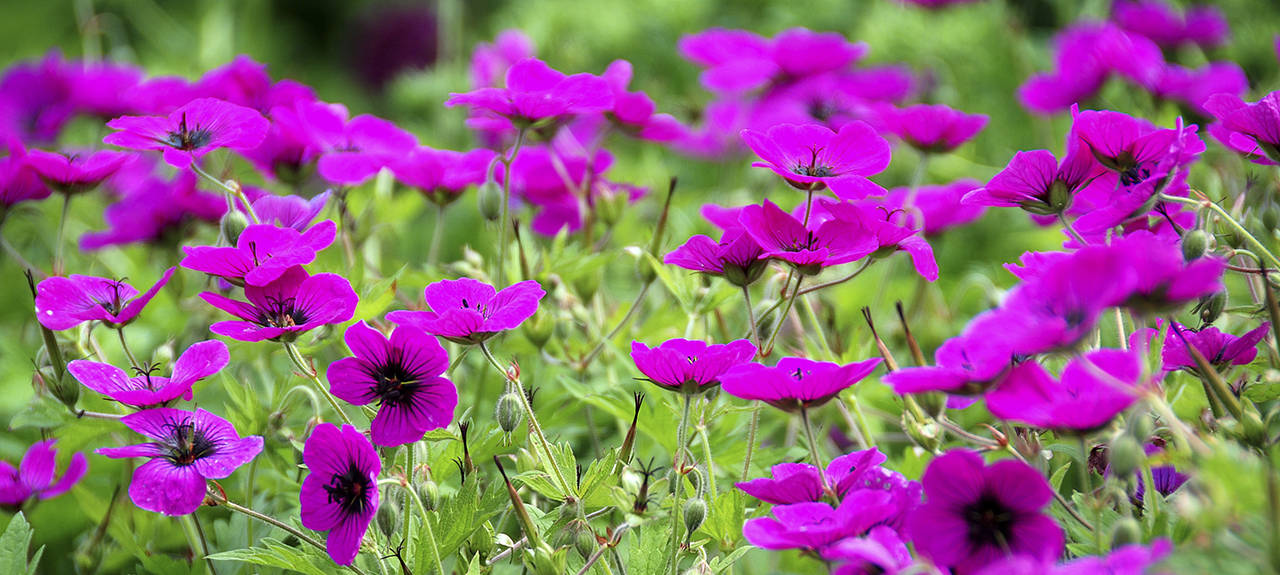Last time around, I described the “E” (eucomis) and “F” (forsythia) on my alphabetical list of favorite plants. Continuing here today are “G” and “H.”
Geranium
The indoor-outdoor plant commonly called “geranium” is botanically known as Pelargonium, which is not a hardy plant.
The cranesbill is mostly a hardy perennial and is considered as the true geranium. It is called this because its fruit capsule looks like the bill of a crane. Easy to grow, cranesbill scamper through the garden either upright or trailing. Some are used as ground covers in perennial borders, rock gardens and fillers for empty spots. There are 30 to 40 species with blue, purple, magenta, pink and white.
In my garden, I use the Biokova geranium as a compact ground cover here and there. Its white and blush pale-pink flowers bloom from late spring to early summer and are easy to propagate by plant division.
Years ago, Johnson’s Blue was the “go to” cranesbill for its lovely true-blue, relatively large flowers; however, deer admired the flowers too much. Later, the Ann Folkard variety appeared and became the favored cranesbill, with its chartreuse leaves and magenta flowers blooming from spring into fall. Then, along came Rozanne, my all-time favorite.
Rozanne is an excellent perennial — robust and vigorous, with one of the longest flowering periods of any cranesbill geranium. Its rare, prolific blue-colored flowers produce masses of gems from late spring to the first frost. Easy to grow, Rozanne is a clump growing about 20 inches tall and spreading 2 or more feet. It is trouble-free, and deer and rabbits don’t like it. Hardy and useful in containers, in borders, and as a ground cover, it’s a winner.
What I love about it is that I use it in my peony bed, which is very tired about the time Rozanne comes on and covers all the dying back foliage of the peonies. It is as spectacular as the bed of blooming peonies.
Cranesbill are not fussy about soil type; they like average or moist soil and do well in full sun or partial shade.
Hosta
For me, it was a difficult decision to choose between hostas and heliotrope to represent “H.” As fond as I am of heliotrope for its fabulous fragrance, it’s mostly an annual. Hostas won this one.
The hosta is a warhorse in the garden, a hardy perennial, and so dependable; it dies back in the fall and reappears every spring without fail. After a couple of years, it can be divided easily in spring to be added elsewhere in your garden or shared with friends.
The glory of a hosta is its foliage. With over 3,000 registered cultivars, there are an unlimited choice for any gardener to select what tickles their fancy. The leaves, with their varied colorations, come in many shapes and forms: glossy or dull, smooth, puckered or both; some with wavy edges; many with colors ranging from light to dark green, chartreuse, yellow, gray and even blue.
Dwarf specimens have leaves 3 to 4 inches across; giant ones can be as broad as 5 feet.
Hostas are generally thought of as shade lovers, but many will tolerate sun in cool summer zones and will even take a considerable amount of sun. All hostas go dormant in winter, collapsing into mush, and are easily removed to tidy the garden.
Native to Eastern Asia, all hostas will have a bloom period. It’s not the flowers, which are rather insignificant, but the spectacular leaves that most gardeners want in their gardens.
Slugs are about the only pest encountered. A small shallow dish of beer put under a plant will attract those pesky slugs, who will slip into the dish but won’t be able to get out (drunk, perhaps?). A little brewer’s yeast with a small amount of sugar mixed with water in a shallow bowl will do the same. A commercial pesticide that does not harm pets or wildlife is also found in most garden centers. Look for iron phosphate as the active ingredient. Trade names include “Sluggo” and “Garden Safe Slug and Snail Bait.”
Deer like some, but not all hostas. Early in spring when new shoots are emerging, about 2 to 3 inches tall, a sprinkle of fish meal on the plants seems to deter deer. It’s rare in my garden that deer will go after a fully emerged plant.
Hostas can be drought-tolerant but prefer a little water, and they are not fussy about soil types. They are considered a low-maintenance perennial.
This article is part of an occasional series in which Master Gardener Dolores Cavanah describes the plants she most admires at her expansive garden at Schafer Meadows, east of Montesano. To learn more about the WSU Master Gardener Program of Grays Harbor and Pacific Counties, visit PNWMG.org.


